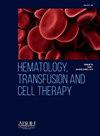SURVIVAL OUTCOMES OF AUTOLOGOUS STEM CELL TRANSPLANTATION IN LYMPHOMA PATIENTS
IF 1.8
Q3 HEMATOLOGY
引用次数: 0
Abstract
Objective
Lymphomas, a diverse group of hematological malignancies, vary significantly in their prognosis, survival outcomes and response to treatment. High-dose chemotherapy followed by autologous stem cell transplantation (ASCT) has been frequently used to treat patients with relapsed or refractory lymphoma, offering a potential for long-term remission. However, survival outcomes after ASCT can differ substantially depending on the type of lymphoma. This study aims to compare survival outcomes across six different lymphoma subtypes—Hodgkin's lymphoma (HL), diffuse large B-cell lymphoma (DLBCL), follicular lymphoma (FL), marginal zone lymphoma (MZL), mantle cell lymphoma (MCL), and T-cell lymphoma—in patients who have undergone autologous stem cell transplantation. While most reported data in the literature focus on a single lymphoma subtype, this study examined multiple subtypes within a single center, allowing for a direct comparison of survival outcomes. This study also aimed to compare these outcomes with survival and relapse rates reported in the literature, identifying potential areas for further investigation into the underlying causes of observed differences.
Methodology
This retrospective study took place at Bezmialem Vakif University Hospital, İstanbul, Turkey. Medical records were reviewed of 81 patients from six different lymphoma subtypes who underwent autologous stem cell transplantation (ASCT) between January 2012 and December 2023. We included 20 HL, 22 DLBCL, 17 FL, 6 MZL, 10 MCL, and 6 T-cell lymphoma patients. Lymphoma diagnoses were confirmed through pathology reports. Data were collected on each patient's age, sex, time of post-transplant relapse, time of death and last follow-up visit from patient records. Only patients who followed up at least 12 months after the ASCT were included for analysis. For survival analysis, research will evaluate overall survival (OS) and progression-free survival (PFS). PFS was defined as the time from transplantation to disease progression, relapse, or death from any cause, while OS was defined as the time from transplantation to death or the last follow-up. PFS and OS were calculated using the Kaplan-Meier method, and survival curves were compared using the log-rank test. Cox proportional hazards regression was used to evaluate the effect of age, sex, and lymphoma subtype on both PFS and OS. A p-value of less than 0.05 was considered statistically significant. Univariate and multivariate logistic regression were used to check how other factors might affect survival outcomes.
Results
A total of 81 patients’ characteristics are summarized in Table 1. Patients aged between 18 and 79 years, with a mean age of 45.79±16.01. A significant age difference was found between HL and other groups and between DLBCL and MCL patients (p < 0.05). 2-year PFS was %72.4 [Standart Error (SE)=%5.3] and OS was %77.6 (SE=%4.8) The estimated mean PFS for the six groups analyzed was 72.45±6.73(SE) months (95% CI 59.25%-85.65%) and the mean OS was 114.03±7.91 (SE) months (95% CI 98.51%-129.55%)(Table 2). When comparing the 2-year PFS for HL, DLBCL, FL, MZL, MCL, and T-cell results were 69.9% (SE=0.114), 80.9% (SE=0.086), 75.5% (SE=0.107), 80% (SE=0.179), 70% (SE=0.145), and 50% (SE=0.204) and 2-year OS were 79.3% (SE=0.092), 57.7% (SE=0.108), 100% (SE=0), 62.5% (SE=0.213), 88.9% (SE=0.105) and 53.3% (SE=0.248) respectively. When we compared PFS and OS durations among the groups, DLBCL had the best PFS with 70.2 months (SE = 9.59, 95% CI 51.4%–89%), while T-cell lymphoma had the worst PFS with 14.66 months (SE=3.92, 95% CI 6.96%–22.36%). For OS, the group with the best outcome was FL with 113 months (SE =8.48, 95% CI 96.36%–129.63%), and the worst outcome was T-cell lymphoma with 33.33 months (SE = 6.76, 95% CI 20.083%–46.583%)(Table 2). No significant differences in PFS (p = 0.311) or OS (p = 0.263) were observed between the groups based on the log-rank test, indicating no statistically meaningful variation in survival between the lymphoma subtypes. Cox regression analysis, adjusted for age and gender, revealed a significant difference in PFS between Hodgkin lymphoma and T-cell lymphoma (p = 0.020). However, no significant difference was found in OS (Table 3). Univariate and multivariate logistic regression analyses did not reveal any statistically significant differences between the groups.
Conclusion
Our study revealed significant differences in survival rates among some groups. T-cell lymphoma patients had worse outcomes for both PFS and OS, while DLBCL showed the best PFS, and follicular lymphoma showed the best OS. Understanding these varying survival expectations after autologous transplantation in different lymphoma types can help identify strategies to improve success rates for those with shorter survival durations. When comparing our study to previous research, both similarities and differences were identified. For Hodgkin's lymphoma, our 5-year PFS was 69.9% and OS was 72.1%, they were higher compared to the 48% PFS and 53% OS reported by Majhail et al. The differences in subtype distribution, with 65% nodular sclerosis and 15% mixed cellular in our cohort compared to 87% and 8% in their study, may have contributed to this variance. For DLBCL, our 5-year PFS was 60.6%, which surpassed the 42.8% reported by Tun et al., possibly due to the younger average age in our cohort (45 vs. 59 years). For follicular lymphoma, the OS was observed to be much higher compared to other studies and to PFS. This may be due to the quick diagnosis and treatment processes in our clinic or the uneven distribution of the sample group. For other lymphoma subtypes, our findings were generally consistent with the literature. The primary limitation of our study is the small sample size, which likely influenced some of the observed differences. The absence of data on patients' risk factors and disease status at the time of ASCT is another limitation. However, the strength of our study is the ability to compare six lymphoma subtypes within the same study. Further research is needed to focus on larger patient cohorts and incorporate detailed evaluations of risk factors in patients undergoing autologous transplantation.
求助全文
约1分钟内获得全文
求助全文
来源期刊

Hematology, Transfusion and Cell Therapy
Multiple-
CiteScore
2.40
自引率
4.80%
发文量
1419
审稿时长
30 weeks
 求助内容:
求助内容: 应助结果提醒方式:
应助结果提醒方式:


